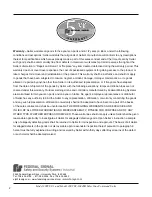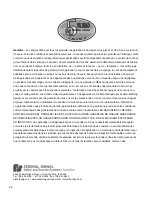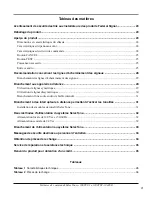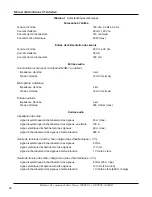
Installation and Maintenance Manual
Model 300VSC-1 and Model 300VSC-1044SB SelecTone Command Units
14
Two Methods of Supplying Power to the SelecTone System
The two basic methods of supplying power to a SelecTone system are 120 Vac 50/60 Hz local power and
24 Vdc central power. The next paragraphs describe each method along with the advantages and disadvantages.
120 Vac 50/60 Hz Local Power
INSTALLATION PRECAUTION
—
Improper installation could render this
system inoperable, interfering with the warning nature of this product. The
installation must conform to applicable local and/or National Electrical codes.
See Figure 5. In this system, power is supplied to each remote SelecTone device by connecting it to a
120 Vac supply in the immediate vicinity of the device. If an emergency power source is required, a
central power system as described below should be employed.
Figure 5 Typical local power system
290A7325
17
4 5
1
16
TB1
TB2
MODEL 300GC
MODEL 300VSC-1
MODEL AM25CK
SIGNAL LINES SHIELDED
TWISTED PAIR
120 Vac
120 Vac
120 Vac
LOCAL PWR.
LOCAL PWR.
POWER LINES
120 Vac
24 Vdc Central Power
See Figure 6 on page 15. In the central power system, all of the remote amplifier power lines are
connected in parallel to one or more centrally located power sources that are 24 Vdc.
The advantages of a central power system are:
✓
The entire system may be independent of local line voltage.
✓
The entire system can be switched to an emergency standby power source in the event of a power failure.
✓
The central power system has the added advantage that an auxiliary power supply, such as the
Federal Signal Model PS600 can be used to power the remote devices in the SelecTone system.
If the PS600 is used, it is not necessary to switch the power source if a power failure occurs.
The disadvantages of a central power system are:
✓
Heavy power lines are required from the power source to the remote devices in the system. The size
of the power lines is dependent upon the number of amplifiers and the total distance of the power
loop in order to minimize the voltage drop while a tone signal is being generated.
✓
Future expansion is limited by the current capacity of the power source and the power lines that
were initially installed.
✓
Central power installations must comply with local electrical codes. Most power circuits are Class I
circuits. Therefore, conduit will probably be required. Installation costs are higher than a local
power system.
Summary of Contents for SelecTone 300VSC-1
Page 55: ...blank page...















































